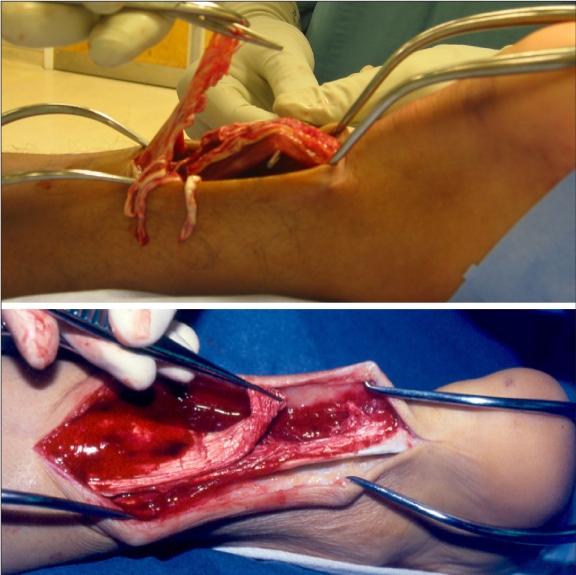The Simmonds–Thompson test, described in 1957 and 1962,1–3 respectively, remains the principal clinical test for rupture of an Achilles tendon. However, there is some discrepancy in the literature regarding its mechanical significance. A positive test has been reported to indicate a complete rupture of the tendon,4 and the cited mechanical reason for the positive test (complete rupture) is the loss of integrity of the soleal part of the tendon. This is consistent with Thompson’s initial description, in which he reported that “… by anatomical dissections ... plantar flexion of the foot depends on an intact soleus muscle attachment to an intact tendon of Achilles.” O’Brien,5 however, reported that a negative test depended on an intact connection of the gastrocnemius aponeurosis to that of the soleus muscle and further described a needle test to assess this.
We report the cases of 2 patients with surgically treated Achilles tendon rupture with positive Simmonds–Thompson tests in which only the gastrocnemius portion of the triceps surae complex was disrupted. In both patients, the Simmonds–Thompson test finding was negative after we repaired the tear.
Case reports
Both patients were in their mid-40s, and both were engaged in a recreational sport when they felt a sharp pain in the back of their legs. Neither had any prodromal symptoms, previous leg injury or a relevant medical history. Both stopped playing and went to the emergency department.
Staff in the emergency department documented a unilateral swollen lower leg and palpable but subtle step deformities of the Achilles tendon in each patient. Both patients could actively plantar flex their ankles but had positive Simmonds–Thompson tests. After we obtained their consent, we scheduled each patient for operative repair, which is the standard treatment for complete ruptures in our unit.
Surgical exploration revealed complete rupture of the gastrocnemius component of the Achilles tendon, whereas the deeper soleal portion of the tendon was intact (Fig. 1). Findings on a repeat Simmonds–Thompson test in the operating room before repair remained positive, but when we restored gastrocnemius continuity the Simmonds–Thompson test was negative.
Fig. 1.
Intraoperative views for both patients demonstrate isolated, complete disruption of the gastrocnemius portion of the triceps surae. Both patients had a positive Simmonds–Thompson test finding. After we repaired the tear, the Simmonds–Thompson test was negative.
Discussion
The Simmonds–Thompson test is likely to remain the primary screening procedure for injury to an Achilles tendon. However, our 2 patients’ cases demonstrate that, although the test indicates a substantial injury to the tendon, it cannot be regarded as diagnostic of a complete rupture. In contrast to previous descriptions using cadaver specimens,4 we have demonstrated in a surgical setting in 2 patients that an isolated disruption of only the gastrocnemius portion of the tendon will also give a positive result. Our findings are consistent with those of O’Brien,5 but for the more distal site of tendon injury. Unfortunately, the needle test described by O’Brien was not done, but, owing to the distal injury, it would likely have given a false-positive result in our patients’ cases as well.
Therefore, when treatment decisions are based on whether a rupture is partial or complete and whether the soleus is involved, the Simmonds–Thompson test alone is insufficient.
Footnotes
Competing interests: None declared.
References
- 1.Simmonds FA. The diagnosis of the ruptured Achilles tendon. Practitioner. 1957;179:56–8. [PubMed] [Google Scholar]
- 2.Thompson TC. A test for rupture of the tendo achillis. Acta Orthop Scand. 1962;32:461–5. doi: 10.3109/17453676208989608. [DOI] [PubMed] [Google Scholar]
- 3.Thompson TC, Doherty JH. Spontaneous rupture of tendon of Achilles: a new clinical diagnostic test. J Trauma. 1962;2:126–9. doi: 10.1097/00005373-196203000-00003. [DOI] [PubMed] [Google Scholar]
- 4.Scott BW, Al Chalabi A. How the Simmonds–Thompson test works. J Bone Joint Surg Br. 1992;74:314–5. doi: 10.1302/0301-620X.74B2.1544978. [DOI] [PubMed] [Google Scholar]
- 5.O’Brien T. The needle test for complete rupture of the Achilles tendon. J Bone Joint Surg Am. 1984;66:1099–101. [PubMed] [Google Scholar]



